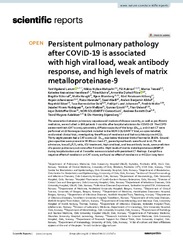Persistent pulmonary pathology after COVID-19 is associated with high viral load, weak antibody response, and high levels of matrix metalloproteinase-9
Permanent link
https://hdl.handle.net/10037/23931Date
2021-12-01Type
Journal articleTidsskriftartikkel
Peer reviewed
Author
Lerum, Tøri Vigeland; Maltzahn, Niklas; Aukrust, Pål; Trøseid, Marius; Nezvalova-Henriksen, Katerina; Kåsine, Trine; Dyrhol-Riise, Anne Ma; Stiksrud, Birgitte; Haugli, Mette; Blomberg, Bjørn; Kittang, Bård Reiakvam; Johannessen, Asgeir; Hannula, Raisa; Aballi, Saad; Kildal, Anders Benjamin; Eiken, Ragnhild; Dahl, Tuva Børresdatter; Lund-Johansen, Fridtjof; Müller, Fredrik; Rivero, Jezabel Rodriguez; Meltzer, Carin; Einvik, Gunnar; Ueland, Thor; Olsen, Inge Christoffer; Barratt-Due, Andreas; Aaløkken, Trond Mogens; Skjønsberg, Ole HenningAbstract
The association between pulmonary sequelae and markers of disease severity, as well as pro-fibrotic mediators, were studied in 108 patients 3 months after hospital admission for COVID-19. The COPD assessment test (CAT-score), spirometry, diffusion capacity of the lungs (DLCO), and chest-CT were performed at 23 Norwegian hospitals included in the NOR-SOLIDARITY trial, an open-labelled, randomised clinical trial, investigating the efficacy of remdesivir and hydroxychloroquine (HCQ). Thirty-eight percent had a CAT-score ≥ 10. DLCO was below the lower limit of normal in 29.6%. Ground-glass opacities were present in 39.8% on chest-CT, parenchymal bands were found in 41.7%. At admission, low pO2/FiO2 ratio, ICU treatment, high viral load, and low antibody levels, were predictors of a poorer pulmonary outcome after 3 months. High levels of matrix metalloproteinase (MMP)-9 during hospitalisation and at 3 months were associated with persistent CT-findings. Except for a negative effect of remdesivir on CAT-score, we found no effect of remdesivir or HCQ on long-term pulmonary outcomes. Three months after hospital admission for COVID-19, a high prevalence of respiratory symptoms, reduced DLCO, and persistent CT-findings was observed. Low pO2/FiO2 ratio, ICU-admission, high viral load, low antibody levels, and high levels of MMP-9 were associated with a worse pulmonary outcome.
Publisher
Springer NatureCitation
Lerum TV, Maltzahn N, Aukrust P, Trøseid M, Nezvalova-Henriksen K, Kåsine T, Dyrhol-Riise AM, Stiksrud B, Haugli M, Blomberg B, Kittang BR, Johannessen A, Hannula R, Aballi A, Kildal AB, Eiken R, Dahl TB, Lund-Johansen F, Müller F, Rivero JR, Meltzer C, Einvik G, Ueland T, Olsen IC, Barratt-Due A, Aaløkken TM, Skjønsberg OH. Persistent pulmonary pathology after COVID-19 is associated with high viral load, weak antibody response, and high levels of matrix metalloproteinase-9. Scientific Reports. 2021;11:1-12Metadata
Show full item recordCollections
Copyright 2021 The Author(s)


 English
English norsk
norsk